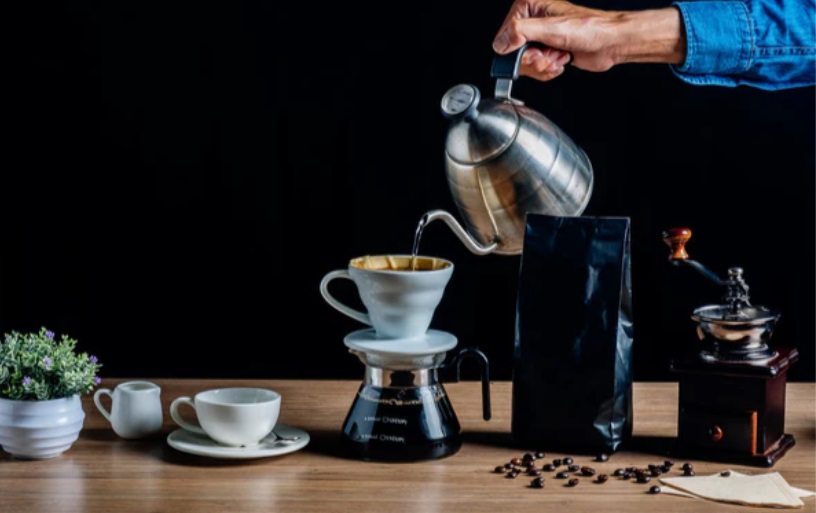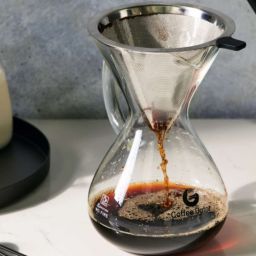
Drip coffee, a staple in many households and coffee shops, is renowned for its simplicity and consistency. This brewing method involves hot water dripping through ground coffee, which is held in a filter, allowing the brewed coffee to collect in a carafe or pot below. Its popularity stems from its straightforward process and the control it offers over the taste and strength of the coffee, making it a favored choice for a daily coffee ritual.
Key Takeaways
- Essential Equipment: To start making great drip coffee, you’ll need a few key pieces of equipment: a reliable drip coffee maker, a good quality grinder for fresh beans, and a proper filter. These tools are crucial for achieving a consistent and tasty cup of coffee.
- Importance of Coffee Freshness and Grind Size: Using fresh coffee beans, ground to a medium consistency, is vital. Freshly ground beans ensure that the coffee’s natural flavors and aromas are preserved, enhancing the overall quality of your brew.
- Water Temperature and Ratio: The temperature of the water used for brewing should be between 195°F and 205°F. This range is ideal for extracting the full flavor from the coffee without pulling out unwanted bitterness. A standard coffee-to-water ratio is 1:16, which means for every gram of coffee, you use 16 grams of water. This ratio balances strength and flavor but feel free to adjust according to your taste.
- Brewing Time: The brewing time can also influence the taste of your coffee. Generally, the brewing process for a standard coffee maker should take about 5 minutes. If your coffee tastes too weak or too strong, adjusting the brewing time might help achieve your desired flavor profile.
Best Way to Make Drip Coffee: Quick Answer
When it comes to brewing the perfect cup of drip coffee, a few key elements come into play. Let’s break these down into manageable bites!
Quality of Water: The water you use can make or break your coffee. Always opt for filtered or bottled water if your tap water isn’t the best quality. This ensures that no impurities interfere with the true flavor of the coffee.
Type of Coffee Beans: Choose high-quality, freshly roasted coffee beans. The origin and roast level of the beans affect the flavor profile, so select beans that match your taste preferences, whether you like a bright, acidic coffee or a richer, darker roast.
Grind Size: The grind size should be medium, similar to granulated sugar. This size is ideal for drip coffee makers and ensures optimal extraction of flavors and oils.
Coffee-to-Water Ratio: A general guideline is to use one to two tablespoons of coffee for every six ounces of water. This can be adjusted depending on how strong you prefer your coffee.
Importance of Clean Equipment: Keeping your coffee maker clean is crucial. Residual oils and build-up from previous brews can impart bitter flavors to your coffee. Regularly clean your machine according to the manufacturer’s instructions.
Equipment and Preparation: Types of Coffee Makers and Grinders
There are various types of drip coffee makers available, from simple models to advanced machines with programmable features. Choose one that suits your daily needs. For grinders, burr grinders are preferred over blade grinders as they provide a more consistent grind size, which is key for great coffee.
Preparing Your Coffee Maker and Water
Before brewing, ensure that your coffee maker is clean and free of any old grounds or residue. Heat your water to the right temperature (between 195°F and 205°F) if your machine doesn’t automatically control it. This preparation helps in extracting the fullest flavor from your coffee beans.
Step-by-Step Brewing Process
Brewing the perfect cup of drip coffee can be both an art and a science. Let’s simplify the process with clear steps and some tips to enhance the flavor of your coffee.
1. Measure Your Coffee and Water
Start by measuring your coffee. A good rule of thumb is to use about 1 to 2 tablespoons of coffee per 6 ounces of water. Adjust this according to how strong you like your coffee. Use a kitchen scale for precision if you prefer your coffee to taste consistent every time.
2. Prepare Your Coffee Maker
Ensure your coffee maker is clean from any previous brews to avoid any stale or bitter tastes. Place a fresh coffee filter in the basket.
3. Grind the Coffee
Grind your coffee beans to a medium grind. Freshly ground coffee beans are preferred as they retain more flavor and aroma. Ensure the grind is uniform to avoid uneven extraction.
4. Boil the Water
Heat your water to between 195°F and 205°F. If your coffee maker doesn’t automatically heat water to this temperature, use a kettle.
5. Brew
Add the ground coffee to the filter and then pour the hot water over the coffee, starting at the outer rim and moving in a steady spiral towards the center. Allow the water to drip through the coffee into the carafe below.
6. Stir the Brew
Once the brewing process starts, gently stir the brew in the filter once. This can help ensure even extraction of the coffee grounds.
7. Wait and Enjoy
Let the brewing process complete before removing the carafe. Serve the coffee immediately for the best flavor, or transfer it to a thermal carafe to keep it hot without burning it.
Tips for Enhancing Flavor
- Use Fresh Beans: Coffee is best used within weeks of being roasted.
- Check Water Quality: Use filtered or bottled water if your tap water isn’t great.
- Mind the Temperature: Water that’s too hot or too cold can make your coffee bitter or flat.
- Clean Your Equipment: Oils and residue from previous brews can impart unwanted flavors.
- Experiment: Adjust grind sizes, coffee-to-water ratios, and brewing times to find what tastes best to you.
Customizing Your Drip Coffee
Customizing your drip coffee allows you to craft a cup that perfectly suits your taste preferences. Here’s how you can adjust the strength and explore the impact of different roasts.
Adjusting Strength and Flavor
To adjust the strength of your coffee, play around with the coffee-to-water ratio. More coffee results in a stronger brew, while less coffee makes it milder. You can also experiment with the grind size; a finer grind will extract more flavor quickly, making the coffee stronger.
Impact of Different Roasts
The roast of the coffee beans greatly affects the flavor:
- Light Roasts: These provide a milder, more acidic flavor and are best for those who appreciate subtle, complex taste notes.
- Medium Roasts: Offering a balanced flavor, acidity, and aroma, medium roasts are ideal for everyday coffee drinkers.
- Dark Roasts: Known for their bold, smoky flavor, these are great if you enjoy a robust coffee that stands up well to cream and sugar.
FAQs
What are the best coffee beans? Look for fresh, high-quality beans from a reputable roaster. The freshness of the beans is more critical than the specific type.
How do I maintain my coffee maker? Regular cleaning is essential. Decalcify your coffee maker with a mixture of vinegar and water every few months to keep it running smoothly.
Troubleshooting bitter coffee? Ensure your water is not too hot and that you are not over-extracting the coffee. Also, check if your coffee beans are too finely ground or overly roasted.
Final Thoughts
Mastering drip coffee is about understanding the basics and then tweaking them to suit your palette. Remember, the perfect cup of coffee is the one that best suits your taste. Experiment with different beans, ratios, and brewing times to find your ideal cup.









